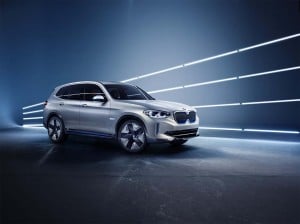
The BMW i3 is one of the market’s more technologically advanced vehicles – and also one of the weirdest looking. Introduced in 2014 and updated for the 2018 model-year, it helped introduce the Bavarian automaker’s distinctive i brand of electrified vehicles.
But with BMW getting ready to roll out a new wave of battery cars, and shift away from its original strategy of using unique platforms for products like the i3 and i8, the iX3 concept making its debut in Beijing this week gives us a good hint of what’s to come.

The concept debuting at the Beijing Motor Show “offers a look ahead to the expansion of the model line-up in this area,” the automaker announced ahead of the formal unveiling. “The first model from the BMW brand to be driven purely by electric power will be a fully-fledged Sports Activity Vehicle – and without compromises when it comes to functionality and comfort.”
With only a few modest exceptions – a distinctive take on the brand’s twin-kidney grille, and a charger port on the front left fender, the iX3 Concept looks like, well, pretty much like a familiar BMW X3. But lift the hood and you’ll discover there’s no internal combustion engine. Instead, it features the automaker’s fifth-generation electric drive system with a single motor producing 200 kilowatts, or 270 horsepower.

In concept form, it relies on a 70 kilowatt-hour battery that, BMW claims, can deliver a range of about 250 miles using the EPA test cycle. And it’s ready to plug into not just a Level 3 fast-charger but one capable of dumping 150 kilowatts of DC current. That will give it another 200 miles – or about 80% of capacity – in less than 30 minutes. (BMW and other European makers are tinkering with even more powerful, 350 kW systems that will be able to deliver 20 miles more range per minute, or nearly what you’d get at a gas tank.)
BMW recently updated the i3 and, among other things, it now gets up to 97 miles in all-electric mode with its optional battery – which jumps to 180 miles once the range-extender option fires up. That approach relies on a small internal combustion engine functioning solely as a generator. It never actually pumps power directly to the wheels.
(EV investment booms in last two years, report says. To find out more, Click Here.)
Boosting range is certain to be welcome in the coming EV market. Most research indicates battery-cars won’t be viewed as acceptable by mainstream buyers until they top 200 miles per charge.

As for the decision to go with a less awkward – if also less distinctive – design? Sandy Munro, the CEO of Munro and Associates, a Detroit consultancy that analyzes and tears down vehicles to see what makes them tick, says only the Tesla Model 3 has a more impressive battery drivetrain than the i3, but “I don’t think I’ve ever seen a vehicle as ugly.”
BMW has spent several years trying to decide what to do with its i brand. The original intent was to populate it with models using unique platforms and distinctive, carbon fiber bodies. But the company has lately reversed course, as TheDetroitBureau.com reported last month.
Instead, BMW now plans to electrify the same platforms it uses for conventional gas-powered models, CEO Harald Kruger said. In other words, the production versions of the planned iX3 and i4 will use the same, underlying architecture as the gas-powered 4-Series models. So will all-electric versions of other conventional models, such as the X3.
(Click Here for details about BMW’s offerings at Auto China in Beijing.)

Meanwhile, the carmaker has developed a mix of modular motor drive systems that could be described as small, medium, large and extra-large. They will be able to be mixed and matched to provide front-wheel-drive, rear-drive or all-wheel-drive.
Any individual model will be able to use up to three packs, one in front and two in the rear, explained Tom Plucinsky, the head of technology communications, delivering up to a combined 750 kilowatts of power. That works out to as much as 1,000 horsepower, “which is M-car territory,” he suggested. In fact, due to the instant-on, high-torque of electric motors, it’s quite possible a future electric-M model will put today’s gas-powered versions to shame. BMW is estimating it could see 0-to-60 mph times of well under 3 seconds.
The current i8 model, which mixes a turbo-gas engine with multiple electric motors, uses a two-speed transmission. Going forward, Plucinsky noted, the plan is to rely on one-speed transmissions because of the incredible RPM range electric motors can operate at with great efficiency.
Those electric motors, meanwhile, will draw power from one of three modular battery packs now under development:
- A 60 kilowatt-hour pack expected to yield as much as 450 kilometers, or 280 miles, range;
- A 90 kWh pack delivering up to 550 km, or 342 miles, range; and
- A 120 kWh pack capable of up to 700 km, or 435 miles range – the pack expected to be used in the upcoming i4.
(For more on BMW’s plans to up EV and AV spending, Click Here.)
The iX3 and recently revealed i4 will set BMW’s electric brand off on its new course. Details about the iX3, including production and launch timing, have yet to be revealed, nor do we know how it will be priced. A base BMW i3, without the REx range-extender option, starts at $44,450. So, stay plugged in for more details to come.








Chris Bangle, where are you. Come home.